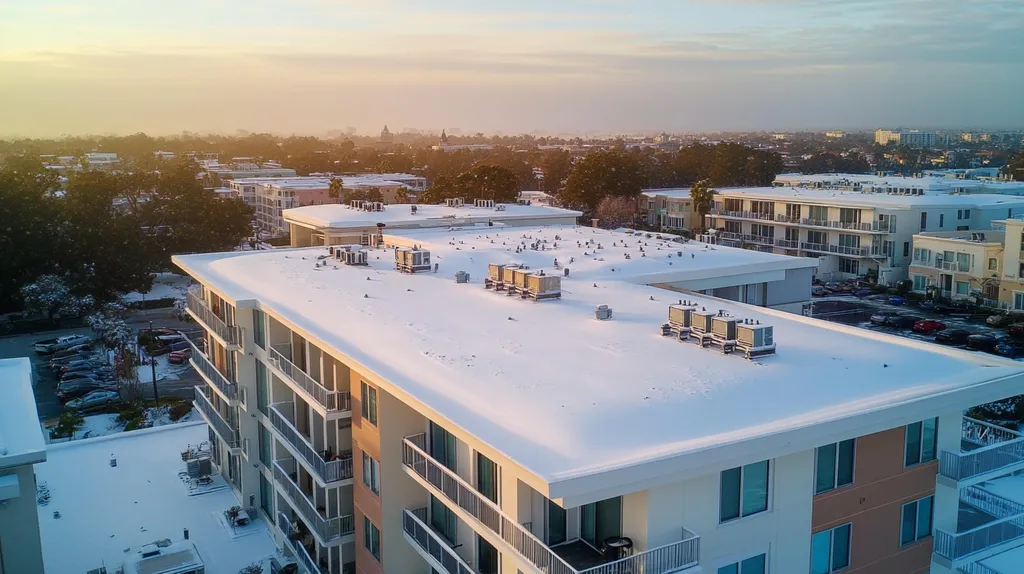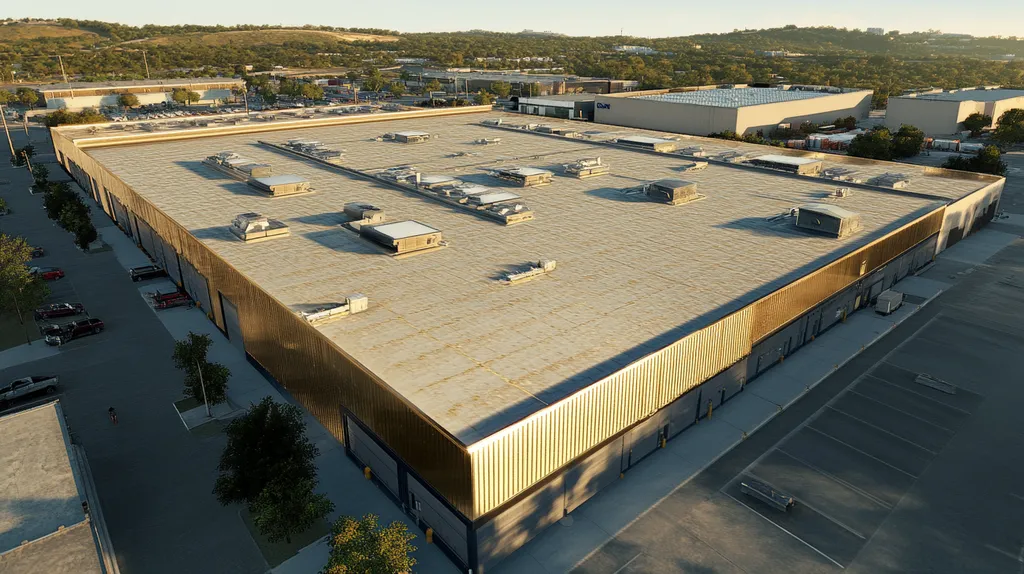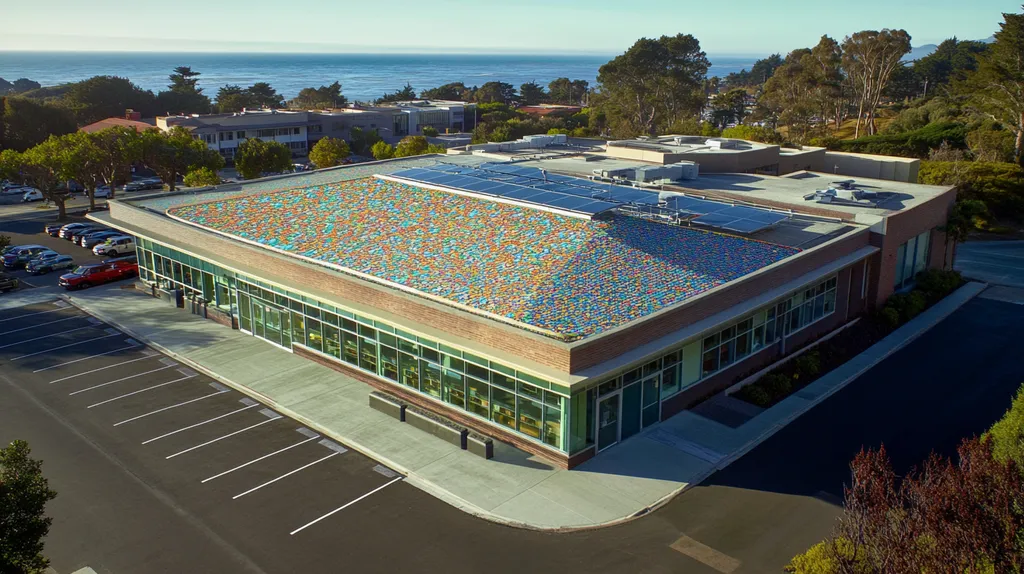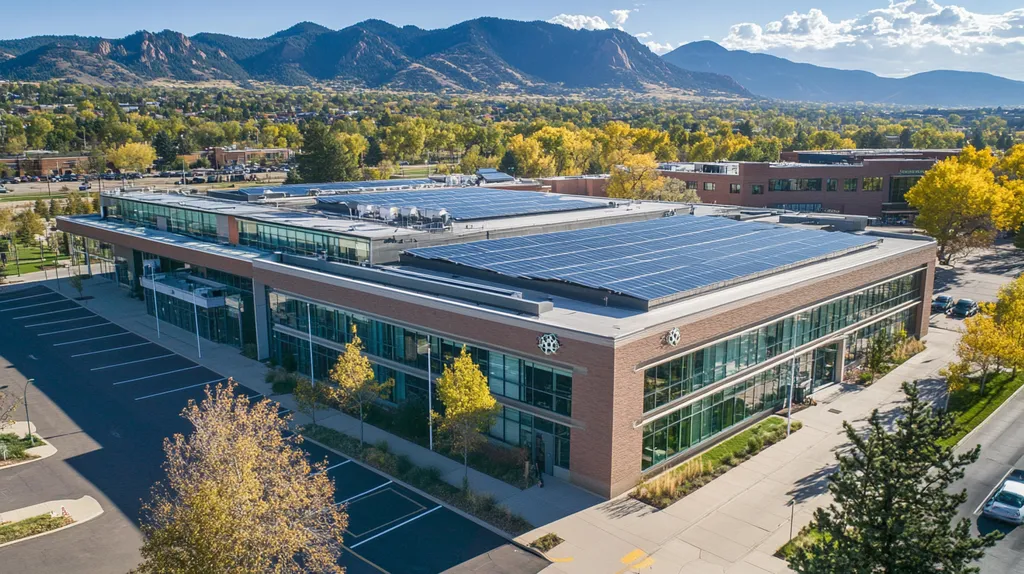Neglected commercial roofs deteriorate up to 50% faster than those receiving proper maintenance, leading to millions in preventable repair costs annually across the commercial real estate sector.
While most property owners recognize the importance of roof maintenance, many overlook the critical role that efficient cleaning plays in extending roof longevity and preventing structural damage.
This comprehensive guide examines the essential factors of commercial roof cleaning, from proper techniques and timing to common pitfalls and industry standards that protect your investment.
SECTION 1: THE BASICS EXPLAINED
Maintaining the cleanliness of a commercial roof is a vital necessity, not a mere option. Accumulation of debris and exposure to harsh chemicals can significantly shorten its lifespan—by as much as 30%, according to research. Grasping the significance of efficient cleaning is crucial for safeguarding your building’s investments. This section delves into what efficient cleaning entails, its importance for your property, and how the process works.
What It Is (In Plain Language)
Efficient cleaning of commercial roofs refers to systematic techniques aimed at removing dirt, debris, and contaminants. Common methods include pressure washing, soft washing, and conducting regular inspections. These practices are designed to maintain the roof’s ability to protect the building from environmental hazards.
Beyond serving as a mere shelter, commercial roofs safeguard valuable assets and ensure tenant safety. By keeping them clean, property owners significantly reduce the risks of water intrusion, mold growth, and other damaging issues.
Implementing effective cleaning strategies contributes to prolonging the life of roofing materials. It also plays a crucial role in enhancing the building’s overall energy efficiency.
For property owners, comprehending the principles of efficient cleaning helps in better managing maintenance schedules and necessary services. Taking proactive steps in cleaning can prevent problems that often result in much higher repair costs down the line.
Why It Matters (To Your Building)
The condition of a commercial roof has a direct influence on operational expenses and overall building performance. Regular cleaning is critical for preserving structural integrity. Dirty roofs can trap debris that collects rainwater, leading to leaks or even structural failures.
Additionally, a well-maintained roof fosters energy efficiency. A cleaner surface improves insulation, which can translate into reduced heating and cooling costs. Buildings that prioritize regular cleaning are better positioned to meet green building standards, further enhancing their sustainability.
Neglecting roof cleanliness can also trigger warranty complications with manufacturers. Many warranties stipulate that regular maintenance, including cleaning, is necessary to maintain their validity.
Ultimately, investing in cleaning routines mitigates significant costs related to repairs and premature roof replacements, thus protecting both the roof and the overall financial health of the property.
How It Works
The process of efficient cleaning starts with a comprehensive inspection to pinpoint problematic areas. Property managers are tasked with evaluating localized debris or growth that may require focused attention. This assessment informs the subsequent cleaning strategy.
Pressure washing employs high-pressure water streams to efficiently eliminate accumulated dirt and contaminants. This method works well on surfaces that can withstand more aggressive cleaning without sustaining damage.
For more sensitive materials, soft washing offers a gentler alternative. This technique uses low-pressure systems combined with biodegradable cleaning agents, minimizing potential wear while effectively cleansing the roof.
Establishing a regular cleaning schedule ensures roofs remain in peak condition. Consistent maintenance paired with timely repairs leads to enhanced longevity and performance.
In conclusion, adopting an efficient cleaning regimen significantly enhances roof health, protects investments, and reduces the chances of costly interruptions to business operations.
SECTION 2: PRACTICAL APPLICATIONS
Efficient cleaning of commercial roofs is essential for maintaining structural integrity and extending lifespan. Regular maintenance can increase a roof’s longevity by up to 50%, preventing costly repairs and operational downtime. Understanding the best practices for cleaning not only safeguards investments but also significantly reduces expenditures related to untimely repairs or replacements.
Common Uses & Examples
Routine roof cleaning serves multiple critical functions, particularly in preventing the accumulation of debris that leads to pooling water, a common issue for flat roofs. For example, regular clearing of leaves and dirt prevents water from stagnating, which can otherwise initiate leaks and structural damage.
In urban environments, roofs often gather significant grime and pollutants. Employing methods like pressure washing and soft washing effectively removes not only dirt but also biological growths, such as moss and algae, which can deteriorate roofing materials over time.
Specialized cleaning solutions can tackle stubborn stains caused by prolonged exposure to environmental elements. These solutions not only clean but also help restore protective coatings that degrade under UV exposure, bolstering the roof’s resilience.
In summary, prioritizing routine cleaning is vital for prolonging roof life and ensuring ideal performance, ultimately resulting in notable savings on future repair costs.
When You Need It Most
Understanding timing is crucial for effective roof cleaning. After heavy rainfall or storms, debris is often washed into gutters and drains, leading to potential clogs. Conducting thorough inspections before and after storm seasons helps nip any issues in the bud and safeguards roof health.
Spring is particularly significant for roof maintenance, as winter can leave behind a buildup of debris, ice melt residues, and biologic growth. Addressing these concerns promptly can prevent long-term damage and costly repairs.
During the late summer months, increased pollen and dust accumulation also necessitates regular cleaning to maintain optimal roof conditions. Facilities managers should align cleaning schedules with seasonal changes to ensure the roof remains in peak condition.
By identifying these critical moments for cleaning, property owners can mitigate damage and considerably extend the lifespan of their roofs.
Interactions With Other Systems
Roof cleaning plays a key role in the efficient functioning of other building systems. A clean roof enhances the performance of HVAC systems by allowing for better air circulation. Conversely, debris accumulation can lead to overheating and undue stress on HVAC equipment.
A roof’s cleanliness is also linked to the effectiveness of the drainage system. Clogged gutters can cause water backup, jeopardizing the roof’s waterproofing integrity. Regular cleaning is essential to ensure that these systems work synergistically.
Moreover, the aesthetic integrity of building facades is affected by roof cleanliness. Debris that falls from unclean roofs can stain walls and lead to damage. Clean roofs contribute positively to the overall appearance and durability of the entire building structure.
By recognizing these interconnections, property owners can develop comprehensive maintenance strategies that ensure both roofs and their integrated systems function efficiently together.
SECTION 3: KEY TERMINOLOGY DECODED
In the realm of commercial roofing, a firm grasp of key terminology is imperative for successful maintenance and cleaning efforts. Property owners and facility managers are often confronted with industry jargon that can be daunting. By familiarizing themselves with these terms, they can avoid costly errors that jeopardize the roof’s integrity and longevity. This section demystifies essential roofing terminology, equipping readers to make informed decisions regarding maintenance strategies.
Essential Terms Explained
One essential term is “membrane,” which denotes the protective layer that sits atop a commercial roof. This layer functions as a shield against harsh weather and environmental contaminants. Knowing the distinctions between membrane types, such as EPDM (Ethylene Propylene Diene Monomer) and TPO (Thermoplastic Olefin), is crucial when determining appropriate cleaning techniques.
Another significant term is “drainage system.” An efficient drainage system prevents water accumulation, avoiding severe damage. Opting for roofs designed with effective drainage solutions can significantly extend lifespan and minimize repair costs.
An additional critical term is “roof inspection.” Regular inspections enable early detection of wear and tear. Identifying issues promptly can result in considerable savings by reducing the need for extensive repairs over time.
Lastly, “roof coating” refers to an applied layer that enhances durability and reflectivity. Choosing the right coating can decrease future maintenance needs and help cut energy expenses.
Industry Jargon Translated
Terms such as “UV resistance” and “thermal performance” frequently appear in roofing discussions. UV resistance indicates a material’s capacity to withstand sun-induced damage, vital for ensuring longevity. Without sufficient protection, roofs may deteriorate rapidly, necessitating more frequent replacements.
“Thermal performance” pertains to a roof’s insulation capabilities against heat and cold. Superior thermal performance not only lowers energy expenditures but also helps sustain consistent internal temperatures. Grasping these concepts is key to making energy-conscious decisions.
“Seam integrity” denotes the robustness of connections between roofing sections. Compromised seam integrity could lead to leaks and significant water damage. Recognizing the importance of quality seams prompts property managers to select reliable materials.
Lastly, “service life” reflects the anticipated lifespan of a roof under normal conditions. Understanding different roofing materials’ service life aids in planning maintenance schedules and budgeting for future repairs.
Measurement & Units Simplified
Familiarity with roofing measurements is paramount for effective maintenance. The term “square” is commonly used in roofing vernacular, defined as a 10×10-foot area, or 100 square feet. Calculating the total square footage of a roof is essential for estimating cleaning costs and determining the amount of materials required.
Another important measurement is “pitch,” which describes the incline of the roof. This aspect can affect both cleaning methods and product selection. Steeper roofs may necessitate specialized equipment or professional intervention for safe cleaning.
“PSI,” or pounds per square inch, quantifies the pressure used in power washing. Understanding the appropriate PSI settings is vital to prevent damage during the cleaning process, ensuring the roof’s integrity is maintained.
Finally, “thermal conductivity” measures a material’s efficiency in conducting heat. A lower thermal conductivity index indicates better insulation properties, enabling property owners to make informed choices about energy-efficient roofing materials.
SECTION 4: DECISION FACTORS
Roof maintenance decisions are pivotal for ensuring the longevity of commercial roofs. Factors such as cost, performance, and expected lifespan can greatly influence outcomes. For example, neglecting proper cleaning routines can result in severe damage, leading to costly repairs or even early roof replacements. Understanding these crucial elements enables property owners and facility managers to make informed, strategic choices regarding roof cleaning and maintenance.
Cost Considerations
Cost is often the primary concern for property owners when planning roof maintenance. While opting for cheaper cleaning services might offer short-term financial relief, this strategy can precipitate greater expenses in the future. Regular, efficient cleaning minimizes the risk of leaks and structural damage, thereby protecting the roofing investment over time.
When evaluating cleaning service options, property owners must weigh the value of the services against potential repair costs from neglect. For instance, committing to an annual cleaning plan often proves financially beneficial, as it helps decrease the frequency and severity of major repairs.
The selection of cleaning materials also affects overall expenses. While eco-friendly solutions may come with a higher upfront cost, they are generally safer for roofing systems and the environment, potentially leading to lower long-term replacement and repair costs.
In summary, developing a comprehensive budget that prioritizes effective cleaning routines will significantly enhance the roof’s integrity and performance in the long run.
Performance Trade-offs
The choice of cleaning method can have significant implications on roof performance. Different techniques yield varying effectiveness and risks; for instance, pressure washing can effectively remove stubborn debris but risks damaging sensitive roofing materials if not correctly applied.
Selecting the appropriate cleaning technique is crucial. Chemical cleaners can be effective, yet they often require thorough rinsing to avoid detrimental residue buildup on the roof. Balancing cleaning effectiveness with the durability of roofing materials is essential for maintaining roof health.
It is also vital to consider the frequency of cleaning. Regularly scheduled cleaning contributes to continued optimal roof performance; however, cleaning too frequently or infrequently can create complications, such as premature wear of roofing materials.
Consulting with professional roofing contractors ensures property owners choose the most suitable cleaning methods tailored to their specific roof types and conditions, thus optimizing performance outcomes.
Lifespan & Durability Factors
The lifespan of a commercial roof is directly affected by its cleanliness and maintenance schedule. Accumulation of dirt, debris, and biological growth significantly reduces effective lifespan. For instance, a neglected roof may experience diminished water drainage, resulting in excessive pooling and leaks.
Durability is likewise influenced by proper cleaning habits. A consistently maintained roof is far less vulnerable to damage from extreme weather events. Regular cleaning preserves protective coatings, mitigating wear and tear from environmental factors.
Ongoing investment in cleaning extends beyond aesthetics; it directly impacts functionality. For example, roofs facing harsh winter climates need special attention to avoid ice dams—a common issue that can lead to expensive repairs.
By proactively managing cleanliness and maintenance, property owners can secure their roofs’ durability and resilience, ensuring they withstand the elements effectively and maximizing long-term investment potential.
SECTION 5: COMMON CHALLENGES
Cleaning a commercial roof may seem straightforward, yet overlooking this critical task can lead to severe consequences. Research shows that improper maintenance can shorten a roof’s lifespan by up to 50%. Property owners and facility managers must be aware of prevalent challenges—such as debris buildup and water pooling—to maintain the integrity of their roofs and avoid significant repair expenses.
Frequent Problems & Solutions
Debris accumulation is a leading challenge for commercial roofs. Leaves, dirt, and other materials can trap moisture, fostering mold growth and leaks. Implementing a routine inspection process and promptly removing debris is essential to mitigate these risks.
Water pooling presents another serious issue, often exacerbated by the roof’s slope or blockages within the drainage system. This stagnation can lead to structural damage and decreased lifespan. Effective drainage solutions, such as properly designed downspouts and scuppers, can significantly alleviate this problem.
Furthermore, inadequate cleaning practices can leave harmful residues that degrade roofing materials over time. Establishing a consistent cleaning schedule and utilizing appropriate cleaning agents, alongside professional services, can prevent material deterioration.
Addressing minor issues promptly is also crucial. Ignoring small repairs can lead to larger, more costly problems in the future. Regular monitoring and immediate attention to repairs can ultimately save significant maintenance costs.
Warning Signs To Watch For
Property owners and facility managers should stay alert for warning signs of overdue cleaning. Stains or discoloration on the roof surface are often indicators of dirt buildup or possible algae and mold growth. Ignoring these signs may lead to extensive damage.
The presence of standing water or puddles after rain is another red flag. This condition can signal inadequate drainage, potentially resulting in water damage to the roof and underlying structures. Conducting regular inspections and addressing drainage issues promptly can prevent such complications.
Cracked or peeling roofing materials serve as indicators of poor maintenance. These damages can worsen over time and result in leaks. Identifying and repairing these cracks swiftly is vital for preserving the roof’s integrity.
Additionally, increasing utility bills can signal declining energy efficiency due to a dirty roof. Regular cleaning helps maintain system efficiency and prevents unexpected operational costs.
Preventative Approaches
Implementing preventative maintenance strategies is crucial for avoiding typical roofing challenges. One effective method is to develop a comprehensive cleaning schedule that corresponds with seasonal changes. Regular cleanings reduce debris accumulation and minimize damage risks.
Engaging professionals for roof inspections and cleanings is another recommended strategy. Experienced roofing experts can spot potential issues early and implement timely solutions, ensuring that roofs remain free from hazards.
Installing protective barriers or coatings enhances a roof’s resilience against environmental elements. These barriers help prevent debris buildup and protect roofing materials from weather-related wear.
Lastly, staff education on roof care is essential. Facility managers should train team members to recognize maintenance tasks that require attention. This proactive approach fosters a culture of vigilance in addressing issues before they escalate into significant problems.
SECTION 6: NEXT STEPS & RESOURCES
Taking action on the efficient cleaning of commercial roofs is not just advisable; it is essential for preserving property value and longevity. Inadequate maintenance can lead to major financial headaches, including repairs that could have been avoided. Research indicates that failing to conduct regular cleaning can cut a roof’s effective lifespan by as much as 30%. Property owners must approach this crucial task with urgency to protect their investment. This section details important questions to pose to potential service providers, highlights key industry standards, and offers additional resources for ongoing learning.
Questions To Ask Providers
Choosing the right roof maintenance provider starts with asking the right questions. First, confirm their experience with the specific roofing materials on your building to ensure they are well-versed in appropriate cleaning approaches. Ask for references to gauge their track record and reliability in past projects.
Inquire about their cleaning methods, focusing on techniques that optimize water efficiency and avoid damage to roofing materials. Understanding their safety protocols is also vital, particularly regarding how they manage high-risk areas on the roof.
Additionally, ascertain their inspection process following cleaning. A thorough protocol for identifying potential issues such as leaks or other signs of wear can prevent future complications. Lastly, discuss maintenance scheduling options—having a reliable follow-up can greatly contribute to the long-term health of your roof.
Industry Standards & Guidelines
Being familiar with industry standards is crucial to ensuring effective and safe roof cleaning. The Roofing Industry Alliance for Progress offers authoritative guidelines regarding recommended cleaning practices and safety measures. Adhering to these standards can significantly reduce risks and promote optimal cleaning results.
The National Roofing Contractors Association (NRCA) also provides essential resources outlining best practices for roofing maintenance. Following these guidelines not only helps in preserving the structural integrity of the roof but also extends its overall lifespan.
Moreover, be aware of local regulations that may pertain to roof cleaning, particularly concerning wastewater disposal and the use of cleaning agents. Keeping informed about these regulations can safeguard against fines and protect the property’s standing in the community.
Further Learning Simplified
To enhance knowledge on commercial roof maintenance, numerous resources are available. Online webinars and courses frequently feature industry experts discussing the latest strategies in roof care and upkeep. These platforms serve as valuable tools for staying current in the field.
Books and articles in industry publications often present comprehensive insights on effective cleaning techniques. Many organizations create content aimed at simplifying complex topics for property owners and facility managers alike.
Lastly, joining professional networks can offer a treasure trove of information and support. Collaborating with fellow facility managers and property owners can yield best practices and shared experiences that improve overall roof management strategies.
The Bottom Line
Research demonstrates that properly cleaned commercial roofs last 40-50% longer than neglected ones, representing hundreds of thousands in savings over a building’s lifetime.
The implementation of efficient cleaning protocols stands as a crucial differentiator between buildings that maintain their value and those that face premature deterioration and costly repairs.
Industry data confirms that systematic cleaning and maintenance programs reduce emergency repairs by up to 70% while extending roof lifespans by decades.
For property owners and facility managers, the message is clear: establishing comprehensive cleaning protocols is not merely a maintenance task—it represents a critical investment protection strategy that directly impacts both short-term operations and long-term asset value.
The time to implement proper cleaning protocols is now, before preventable damage occurs.
FREQUENTLY ASKED QUESTIONS
Q. Why is efficient cleaning of a commercial roof necessary?
A. Maintaining cleanliness on a commercial roof is essential for its longevity. Accumulation of debris can shorten operational lifespan by as much as 30%, as it leads to potential leaks and water damage. Efficient cleaning practices protect the roof’s integrity, ensuring it continues to fulfill its role in safeguarding the property.
Q. What cleaning methods are effective for industrial roofs?
A. Effective cleaning methods for industrial roofs include pressure washing and soft washing, tailored to the roofing material. Regular inspections help identify specific areas requiring attention. Implementing these methods not only removes unwanted debris but also minimizes issues like mold growth and water pooling.
Q. How does roof cleanliness relate to energy efficiency?
A. A clean roof significantly improves energy efficiency by enhancing insulation properties. Dirty surfaces can lead to higher operational costs due to increased heating and cooling demands. By prioritizing regular cleaning, property owners can maintain optimal internal temperatures and reduce energy expenses.
Q. What key terms should I know about cleaning a commercial roof?
A. Key terms include “membrane,” which denotes the protective layer, and “drainage system,” crucial for preventing water accumulation. Understanding these terms aids in selecting proper cleaning techniques and materials, ultimately protecting the commercial roof from potential damage.
Q. What factors should influence my decision on roof cleaning?
A. Cost, cleaning technique, and expected roof lifespan are pivotal decision factors. Regular cleaning is an investment that minimizes future repair costs by reducing the risk of serious damage. Evaluating these factors helps ensure that cleaning strategies align with maintenance goals.
Q. What common challenges arise during commercial roof cleaning?
A. Common challenges include debris accumulation and water pooling, which can lead to leaks. Implementing a regular inspection regime and targeted cleaning strategies helps mitigate these issues. Neglecting routine maintenance can result in substantial repair costs and reduced roof lifespan.
Q. What steps should I take after deciding to clean my commercial roof?
A. Begin by researching service providers, focusing on their experience with your roof type. Ask relevant questions regarding their cleaning methods and safety protocols. Familiarizing yourself with industry standards ensures compliance and optimizes cleaning effectiveness, safeguarding your investment in roof longevity.











